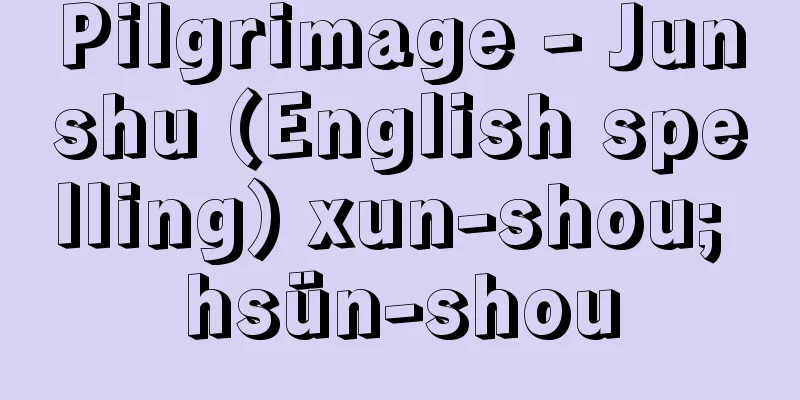Oinosho - Oinosho

|
This manor was owned by Todaiji Temple and was located in Anpachi County, Mino Province. It is now Ogaki City, Gifu Prefecture. The circumstances of its establishment are unclear, but it is said that Todaiji Temple was donated by Emperor Shomu in 756 (Tenpyo Shoho 8). By around 950 (Tenryaku 4), over 50 cho of rice fields had been donated, and the silk tax was used as the fee for the Kegon-e and Hokke-e festivals. According to the claims of the provincial governors at the time of the manor reorganization in 1069 (Enkyu 1), there were only 20 cho of honmen-den (main exempted fields), but by 1214 (Kenpo 2), during the early Kamakura period, this had expanded to over 172 cho of gensaku-den (substitute fields). The Onakatomi clan, descendants of Onakatomi Nobukiyo, who is said to have made great efforts in the development of the manor, inherited the position of Geshishiki and became the center of the manor official organization. The clan owned 69 cho of Ishikanemyo (Geshiname) and were the de facto rulers of the area, but due to internal divisions within the clan, they fell into decline in the latter half of the 13th century. After that, local rule by Kumon, Tadokoro, and Geshidai continued until the Nanboku-cho period, but the heavy burden of taxes, the imposition of military rice and labor duties by the shugo and local samurai class, and losses due to major floods were a series of events, causing many farmers to flee and resulting in a situation where hundreds of kan of taxes were not paid each year. In the Muromachi period, in 1423 (Oei 30), the peasants fled, and local lords such as Ogaki Ujinobu and Nishio Naonori took over as local governors, almost completely destroying Todaiji's ability to collect taxes. In 1543 (Tenbun 12), the regular envoy Gyoshin visited the area, but only 30 kanmon was collected as taxes, and only 18 kan 300 mon was delivered to Todaiji. [Koizumi Yoshisuke] "Gifu Prefecture History: General Edition, Middle Ages" (1969, Gifu Prefecture) Source: Shogakukan Encyclopedia Nipponica About Encyclopedia Nipponica Information | Legend |
|
美濃(みの)国安八(あんぱち)郡にあった東大寺領荘園(しょうえん)。現在の岐阜県大垣市。成立事情は明らかでないが、東大寺は、756年(天平勝宝8)聖武(しょうむ)天皇から施入されたものと伝える。950年(天暦4)ころまでには50町余の田数が注進され、その年貢絹は花厳会(けごんえ)、法花会(ほっけえ)の料足(りょうそく)にあてられた。1069年(延久1)の荘園整理の際の国司側の主張によれば、本免田(ほんめんでん)20町にすぎなかったが、鎌倉初期の1214年(建保2)には見作田(げんさくでん)172町余に拡大されている。当荘の発展に力を尽くしたと伝えられる大中臣信清(おおなかとみののぶきよ)の子孫大中臣氏が下司職(げししき)を相伝し、荘官組織の中心となった。同氏は石包名(いしかねみょう)(下司名)69町余を所有し、在地の事実上の支配者であったが、一族の内部分裂により、13世紀の後半に至り没落した。その後は公文(くもん)、田所(たどころ)、下司代による在地支配が南北朝時代まで続いたが、年貢の重圧、守護や在地の武士層による兵粮米(ひょうろうまい)・夫役(ぶやく)の賦課、大洪水による損亡などが相次ぎ、多くの農民が逃亡し、年々の未進年貢数百貫と称する事態となった。室町時代に入ると、1423年(応永30)に地下(じげ)農民の逃散(ちょうさん)がおこり、在地土豪大垣氏信(おおがきうじのぶ)、西尾直教(にしおなおのり)などによる代官請負が行われることとなり、東大寺の年貢収納の能力はほぼ完全に解体した。1543年(天文12)に定使(じょうし)行真(ぎょうしん)が在地に下向したが、収納した年貢はわずか30貫文で、東大寺に届けられたのは18貫300文余にすぎなかった。 [小泉宜右] 『『岐阜県史 通史編・中世』(1969・岐阜県)』 出典 小学館 日本大百科全書(ニッポニカ)日本大百科全書(ニッポニカ)について 情報 | 凡例 |
Recommend
Kobori Enshu - Kobori Enshu
A samurai and tea master from the early Edo perio...
Queen Substance
…All worker bees are female, and as long as there...
Water Drum
… The mouth harp is sometimes called a Maultromme...
"Dr. Quatermass" series
…A British film company that has become synonymou...
Oganesian, YT - Oganesian
…Element 106 was synthesized in 1974 by A. Ghiors...
Genkashugi (English spelling) cost basis
This principle valuates a company's assets bas...
A summary of the biographies of Japanese monks - Nihon kousoden yōmonshō
Written by Sosho of Todaiji Temple in 1249-1250, t...
dioecesis
…The Roman Senate became nothing more than a metr...
Gazaka
...It is a small city located 150 km southwest of...
Ascarite
...It is a strong base whose granules do not easi...
Talocrural joint - Talocrural joint
…All of these bones can be felt from the surface ...
Wadannoki - Wadannoki
A small evergreen tree of the Asteraceae family. ...
Bell-Magendie's law
The law that states that the ventral roots of the ...
K2 [Mountain] - K2
The highest peak in the Karakoram range. It is loc...
Chemical nitrogen fixation in space - Chemical nitrogen fixation in space
...There are chemical and biological processes th...









